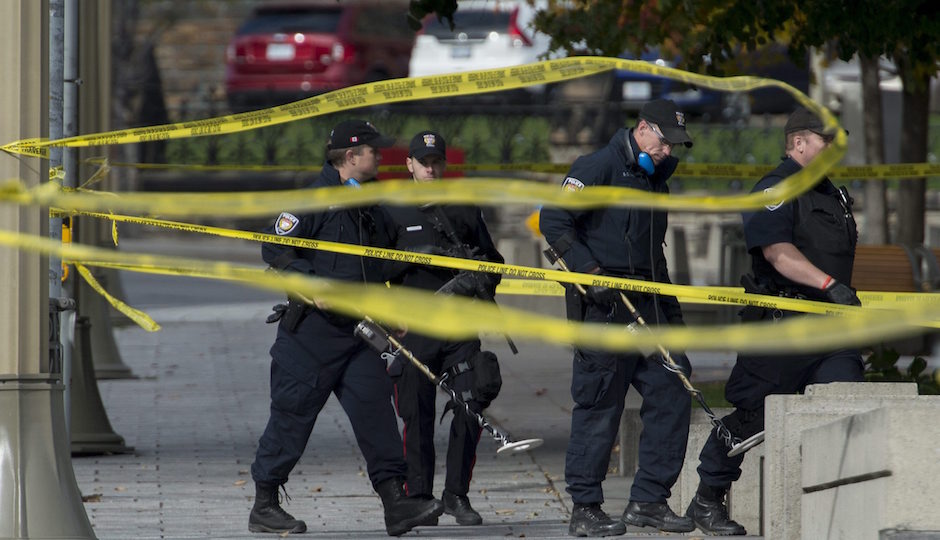On Ottawa Shootings, TV News Got It Wrong. Again.

Police with metal detectors comb the area near the National War Memorial near Parliament Hill, where Cpl. Nathan Cirillo, 24, was killed by a gunman, in Ottawa on Thursday, Oct. 23, 2014. A gunman opened fire at the National War Memorial, then moved to nearby Parliament Hill and wounded a security guard before he was shot, reportedly by Parliament’s sergeant-at-arms on Wednesday. (AP Photo/The Canadian Press, Justin Tang)
I was at home watching cable news when the shooting in Ottawa, Canada broke. What followed was the all-too-familiar routine of wall-to-wall coverage on all the cable news channels. I have been on both sides of the screen in these moments of all-hands-on-deck-throw-out-the-rundown-way-too-frenetic-coverage of breaking news stories.
But this time was a little different. This time I assumed almost everything I was being told, aside from the most basic facts of the unfolding story, were wrong.
And I was right.
I changed back-and-forth from CNN, to MSNBC to Fox News and the same misinformation was being passed along as fact. After the fifth or sixth report of a second, possibly a third gunman, attributions and qualifiers were dropped and rumors became real.
Cable news showed maps of the section of the city where the shootings occurred, highlighting the War Memorial, Parliament, and a nearby shopping mall — the scene of “three separate shootings” in “what is obviously a coordinated attack.” It wasn’t and there weren’t.
The novelette was being written on the fly. The plot line: a well-planned terrorist attack by a team of ISIS gunmen on three separate locations in the Canadian capital city. And once again, none of that turned out to be true. Facts are mixed with rumors and false reports to create fiction in hopes of keeping viewers glued to the set. And it works. But as ratings jump, trust falls.
After the media bumbling in the collective network coverage of the Sandy Hook shooting, the Boston Marathon Bombing and the Washington Navy Yard shooting, one would like to believe that mistakes were not just acknowledged, but the process rectified so that they not happen again. That doesn’t happen in TV news. No time. It is crisis-driven. The Ukraine turns into ISIS, which turns into Ebola. Each one is the most important, most dangerous thing in the world, until the next most important, most dangerous thing in the world replaces it.
In that cycle, there is no time for self-reflection or maintenance. So what is broken stays broken.
During the tragedy of the Sandy Hook elementary school, the media reported on a second gunman; there wasn’t. They identified the shooter as Ryan Lanza and showed a picture; it wasn’t him, it was his brother. CBS anchor Scott Pelley recently spoke at Quinnipiac University in Connecticut and remembered reporting that Nancy Lanza was a teacher at the school and was attacked by her own son in her own classroom. “It was a hell of a story,” remembers Pelley. “But it was dead wrong.” But it still was a hell of a story and isn’t that all that matters in the moment?
Four months later, at the scene of the Boston Marathon Bombings, several networks again reported more bombings than there were, showed the pictures of suspects who weren’t suspects, gave false descriptions, and reported on an arrest when there was no arrest.
During the coverage of the Washington Navy Yard shooting, networks identified the shooter as Rollie Chance and showed his picture, lifted from Facebook; only he wasn’t the shooter. They claimed there was more than one shooter. There wasn’t.
The media apparently craves for more than one shooter, ignoring the most basic fact that the police never assume that there is only one shooter, for that can be a life or death assumption. The proper way to report a continuing scene is: “Police are still on high alert in case there is another gunman. This is standard procedure in these situations.”
It is inexcusable that he same mistakes are repeated every time with no consequence except the increased skepticism of the viewing public.
In place of reform, there are excuses. We are told by news executives to accept that some erroneous information will slip through during a fluid situation, like generals explaining that news wars have “acceptable casualties.”
In America it has become more important to be first than right, as one of the sacrosanct tenets of journalism has been flipped on its head.
There must be a better way of covering breaking news.
There is.
Mother Jones reports that the Canadian Broadcasting Corporation and CBC anchor Peter Mansbridge “gave a master class in calm, credible breaking news reporting.”
Mansbridge tried a unique approach. He was honest with his viewers. At 11:10 AM, Mother Jones reports, he calmly said the following:
MANSBRIDGE: “And so, the situation is, as we say, tense and unclear. And it’s on days like this—we keep reminding you of this and it’s important—it’s on days like this, where a story takes a number of different pathways, a number of changes occur, and often rumors start in a situation like this. We try to keep them out of our coverage, but when they come, sometimes from official sources, like members of Parliament; you tend to give them some credence. But you carefully weigh it with what we’re also witnessing. It’s clear that the situation is not over. It is clear the police are in an intense standby situation and continue to be on the lookout, and until somebody blows the all-clear on this we will stay on top of it and watch as events unfold.”
It wasn’t a perfect prelude, but it was intensely honest. Mansbridge was telling those watching that we are in this together.
I just wish I got CBC on cable in Philadelphia, so I could trust again.
Follow @LarryMendte on Twitter.


